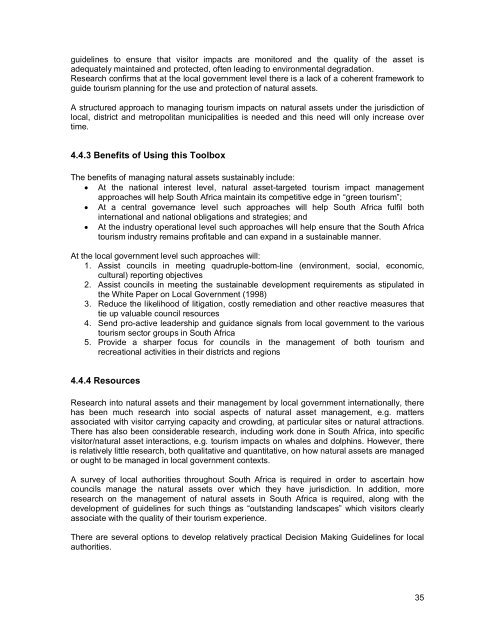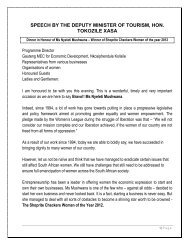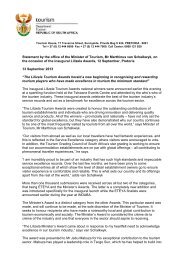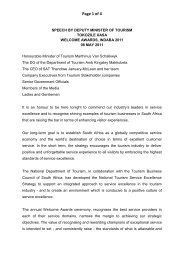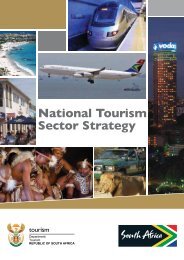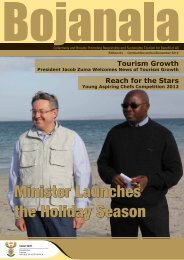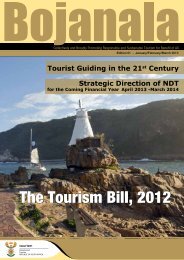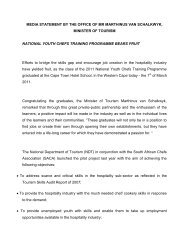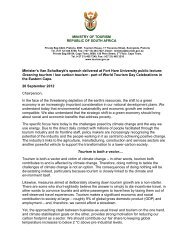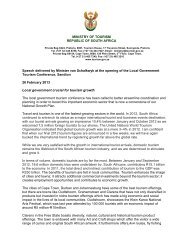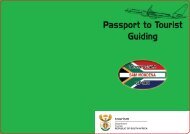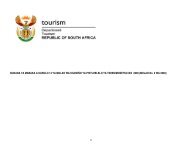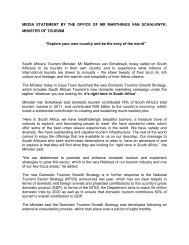The South African Tourism Planning Toolkit - Department of Tourism
The South African Tourism Planning Toolkit - Department of Tourism
The South African Tourism Planning Toolkit - Department of Tourism
You also want an ePaper? Increase the reach of your titles
YUMPU automatically turns print PDFs into web optimized ePapers that Google loves.
guidelines to ensure that visitor impacts are monitored and the quality <strong>of</strong> the asset isadequately maintained and protected, <strong>of</strong>ten leading to environmental degradation.Research confirms that at the local government level there is a lack <strong>of</strong> a coherent framework toguide tourism planning for the use and protection <strong>of</strong> natural assets.A structured approach to managing tourism impacts on natural assets under the jurisdiction <strong>of</strong>local, district and metropolitan municipalities is needed and this need will only increase overtime.4.4.3 Benefits <strong>of</strong> Using this Toolbox<strong>The</strong> benefits <strong>of</strong> managing natural assets sustainably include: At the national interest level, natural asset-targeted tourism impact managementapproaches will help <strong>South</strong> Africa maintain its competitive edge in “green tourism”; At a central governance level such approaches will help <strong>South</strong> Africa fulfil bothinternational and national obligations and strategies; and At the industry operational level such approaches will help ensure that the <strong>South</strong> Africatourism industry remains pr<strong>of</strong>itable and can expand in a sustainable manner.At the local government level such approaches will:1. Assist councils in meeting quadruple-bottom-line (environment, social, economic,cultural) reporting objectives2. Assist councils in meeting the sustainable development requirements as stipulated inthe White Paper on Local Government (1998)3. Reduce the likelihood <strong>of</strong> litigation, costly remediation and other reactive measures thattie up valuable council resources4. Send pro-active leadership and guidance signals from local government to the varioustourism sector groups in <strong>South</strong> Africa5. Provide a sharper focus for councils in the management <strong>of</strong> both tourism andrecreational activities in their districts and regions4.4.4 ResourcesResearch into natural assets and their management by local government internationally, therehas been much research into social aspects <strong>of</strong> natural asset management, e.g. mattersassociated with visitor carrying capacity and crowding, at particular sites or natural attractions.<strong>The</strong>re has also been considerable research, including work done in <strong>South</strong> Africa, into specificvisitor/natural asset interactions, e.g. tourism impacts on whales and dolphins. However, thereis relatively little research, both qualitative and quantitative, on how natural assets are managedor ought to be managed in local government contexts.A survey <strong>of</strong> local authorities throughout <strong>South</strong> Africa is required in order to ascertain howcouncils manage the natural assets over which they have jurisdiction. In addition, moreresearch on the management <strong>of</strong> natural assets in <strong>South</strong> Africa is required, along with thedevelopment <strong>of</strong> guidelines for such things as “outstanding landscapes” which visitors clearlyassociate with the quality <strong>of</strong> their tourism experience.<strong>The</strong>re are several options to develop relatively practical Decision Making Guidelines for localauthorities.35


